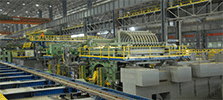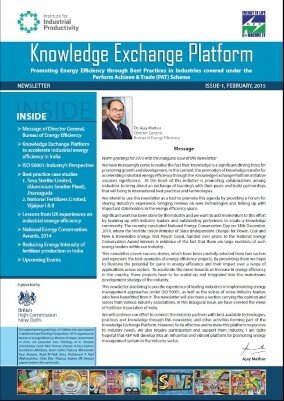Energy Management Systems Database
ISO 50001 is based on the management system model of continual improvement also used for other well-known standards such as ISO 9001 or ISO 14001. This makes it easier for organizations to integrate energy management into their overall efforts to improve quality and environmental management.
ISO 50001:2011 provides a framework of requirements for organizations to develop a policy for more efficient use, fix targets and objectives to meet the policy, use data to better understand and make decisions about energy use, measure results , review how well the policy works and continually improve energy management.
This section contains the detailed case studies adopted by leading industries who have implemented energy management system.
Resource Name: Implementation of Energy Management System ISO 50001, at Captive Power Plant, National Aluminium Company Limited, Angul, Odisha
Abstract: The scope of the energy management system was identified which included the “Operation of 10 X 120 MW coal fired thermal power plant at NALCO captive power plant, Angul”.The coal transportation from MCL to the captive power plant is not within the boundary of ISO 50001 as NALCO does not have operational control over this activity. Various processes were identified and exhaustive energy review was carried out in all the processes by taking energy loss aspects into consideration. The certificate on ISO-50001:2011 was issued by M/S DNV Netherlands on 11 February-2013
Published by: Presentation by Mr. Arpan Ghosh, DGM (Elect), at the workshop on “Best Practices in Energy Efficiency in Thermal Power Sector” on 28th October, 2015 at Dahanu, Maharastra
Resource: Presentation on benefits of implementing ISO 50001 at NALCO, CPP Plant, Angul
Resource Name: Implementation of ISO 50001, Energy Management System at Ballarpur Industries Limited, Shree Gopal Unit
Abstract: Implementation of the Energy Management System, which began in the organization in May 2012, was made easier by the fact that 2012 other management systems, QMS, EMS, OHSAS and FSC, had already been established there for some time. The CGM and Unit Head initiated the process of implementing ISO 50001; a consultant, Quality Growth Services (QGS), from New Delhi was hired to train mill employees and contractors through programs.
Published by: KEP Newsletter Issue 3, September, 2015
Resource: Case Study on benefits of implementing ISO 50001 at Ballarpur Industries Limited, Shree Gopal Unit
Resource Name: Introduction to ISO 50001 and its implementation at National Aluminium Company Limited, Semlter plant, Angul
Abstract: Prior to establishing an Energy Management System, it was essential to gather background data on energy usage and consumption so that baselines can be determined. Background data was extracted from meter readings records and fuel issue records and then the scope and boundaries were established. Transportation of products from Smelter plant to stockyards or customers by railway rakes or trucks on road is excluded from the scope of EnMS at Smelter as Smelter management does not have operational control over the same.
Published by: Presented by Mr. S.K. Jena, AGM (Mech) at the workshop on “Best Practices in Energy Efficiency in Aluminium Sector” on 24th April, 2015 at Jharsuguda, Odisha.
Resource: Case Study on benefits of implementing ISO 50001 at NALCO, Smelter Plant
Resource Name: ACC’s Energy Management System-ISO 50001 Journey
Abstract: ACC started the journey towards implementing ISO 50001 in 2012, and at present, most of ACC plants are ISO 50001 certified. ACC plants were among those from the cement industry that led the initiative to implement ISO 50001. With systems and processes in place, and much experience with ISO 9000 and ISO 14000 systems, it was rather simple to implement ISO 50001, and percolated smoothly through the organization; benefits were also reaped quickly.
Published by: KEP Newsletter Issue 1, February, 2015
Resource: Case Study on benefits reaped by ACC by implementing ISO 50001
Resource Name: UltraTech’s Energy Management System-ISO 50001 Journey
Abstract: For UltraTech, ISO 50001 provided a platform to develop and implement an energy policy, establish objectives, targets and action plans, which take into account legal requirements and information related to significant energy use. The exercise had multiple benefits, the most significant being a change in the approach of all employees towards energy management. It also improved the carbon footprint of the organization.
Published by: KEP Newsletter Issue 1, February, 2015
Resource: Case Study on experiences and learnings by implementing ISO 50001-UltraTech Cement Limited


